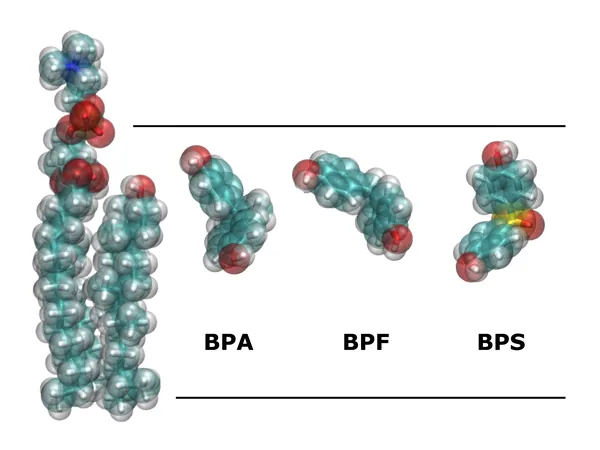
Alarming Study Reveals "Safe" BPA Alternatives Could Be a Hidden Health Threat!
2024-11-18
Author: Charlotte
A groundbreaking study conducted by Professor José Villalaín from the Miguel Hernández University of Elche (UMH) in Spain has unveiled shocking findings regarding bisphenol analogs BPF and BPS, which are being promoted as safer alternatives to the notorious chemical bisphenol A (BPA). Published in the Journal of Xenobiotics, this research raises serious concerns about the potential health risks associated with these substitutes.
Professor Villalaín utilized advanced computer simulations to investigate how BPF and BPS behave within biological membranes. The results are troubling: these compounds can accumulate in human cells, disrupting endocrine function and potentially leading to severe health issues such as obesity, diabetes, and cardiovascular diseases.
While European health authorities have taken decisive action against BPA—implementing legal restrictions and warning the public of its health risks—this new study sheds light on the fact that BPF and BPS may not be as benign as previously believed. In fact, they might cause the same detrimental effects as BPA, highlighting a critical gap in current safety regulations for these bisphenol alternatives.
The research focused on how these chemicals interact with human cell membranes, revealing that BPF and BPS are remarkably similar to BPA. This similarity allows them to accumulate in cells and alter the properties of membrane lipids, potentially leading to adverse health effects. The study emphasizes the concern around endocrine disruptors—substances that interfere with hormone functions and can lead to significant health challenges.
It’s astounding to note that endocrine disruptors are found in everyday products, including plastic bottles, food containers, metal coatings, detergents, flame retardants, and even personal care items like cosmetics. Some toxic substances such as DDT have been banned, while others like BPA are under tightening scrutiny, thanks to ongoing research pointing to their harmful effects across all demographics.
The alarming conclusion drawn from the UMH study is that BPF and BPS, which were previously seen as safer alternatives, share many of the concerning characteristics of BPA. In fact, their ability to interfere with endocrine signaling could be just as dangerous. “Given the significance of these substances for both environmental and human health, it is essential to reconsider their use,” warns Professor Villalaín.
Compounding these worries, recent studies have indicated that elevated levels of BPF and BPS are frequently detected in urine samples from adults in Europe. Research links these compounds to increased risks of various health issues, including cancer and cardiovascular diseases.
The study reinforces the urgent need for more comprehensive regulations addressing not only BPA but also these supposed alternatives, which are proving to be anything but safe. As scientists continue to unravel the complexities of these compounds, it begs the question: How many other "safe" substances in our daily lives carry hidden dangers?
Stay informed and vigilant; the safety of many widely used chemicals could be more precarious than we realize!









 Brasil (PT)
Brasil (PT)
 Canada (EN)
Canada (EN)
 Chile (ES)
Chile (ES)
 España (ES)
España (ES)
 France (FR)
France (FR)
 Hong Kong (EN)
Hong Kong (EN)
 Italia (IT)
Italia (IT)
 日本 (JA)
日本 (JA)
 Magyarország (HU)
Magyarország (HU)
 Norge (NO)
Norge (NO)
 Polska (PL)
Polska (PL)
 Schweiz (DE)
Schweiz (DE)
 Singapore (EN)
Singapore (EN)
 Sverige (SV)
Sverige (SV)
 Suomi (FI)
Suomi (FI)
 Türkiye (TR)
Türkiye (TR)